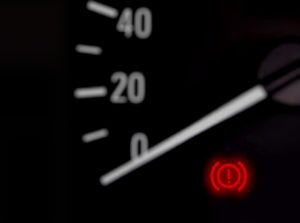The brake warning light will come on with engine ignition and if all is well, should go out shortly after the engine has started. The brake warning light illuminates on the dashboard for various reasons.
Reasons also vary depending on the make and model of your vehicle due to some cars having dedicated fault lights for specific problems, whilst others may have a single fault light that covers many issues. If the light comes on while driving, or stays on after you have started the engine, the possible reasons are as follows:
- Low brake fluid levels
- Brake pads require replacing
- Anti-lock braking system (ABS) fault / Sensor fault
- Parking brake is on / stuck
Brake Warning Light due to Low Brake Fluid Levels
A car’s braking system comprises of airtight tubes full of hydraulic brake fluid. As you press the brake pedal, the fluid in the tubes is pressurised, which in turn pushes the brake pads onto the rotating brake discs to slow or stop a vehicle using friction.
Brake fluid levels should remains relatively consistent, though as the brake pads wear down, more fluid is required to maintain pressure. As a result, fluid levels may drop slowly over several months.
If brake fluid levels drop quickly or fluid levels require topping up frequently, it indicates that you have a leak in your braking system. If your brake warning light comes on, the easiest first thing to check is the brake fluid reservoir under the bonnet / hood.
Other symptoms of low brake fluid is the pedal feeling soft and spongy rather than firm when it’s pressed. This indicates air in the brake pipes and requires immediate attention due to a severe decrease in braking ability.

Brake Warning Light due to Worn Pads
The brake light may also come on due to the brake pads wearing low. Some vehicle manufacturers equip their cars with sensors that warn the driver that around 15% of usable brake pad depth is remaining.
The generic brake warning light may illuminate, or on some vehicles if equipped with a sensor, a specific low brake pad warning light may come on instead. The low brake pads symbol may also contain a red exclamation mark.
Have your brake pads inspected and replaced if necessary. Driving with heavily worn pads will eventually damage the brake discs which will also require replacing at a much increased cost. Excessively worn pads will also degrade braking ability and potentially may see vehicle insurance deemed void in the event of an accident. Badly worn brake pads and/or damaged discs will also result in an MOT failure.
Brake Warning Light due to ABS
When the wheels are locked, a vehicle will not steer in the direction intended by the driver. The anti-lock braking system, or ‘ABS’ is used in most modern cars to prevent the wheels from locking in the event of heavy braking, or otherwise where the wheels might lock due to adverse weather or road conditions.
The brake warning light may come on if there is a fault with the ABS or with the ABS sensor. However, certain vehicles have a specific ABS fault symbol that illuminates when a fault occurs and may show in either red or yellow.
ABS is a completely separate system to your normal car brakes and if ABS fails, normal braking will remain functional. Though an ABS fault does not require immediate attention, repair of the fault should be sought quickly due to the safety features it provides.
Brake Warning Light due to Parking Brake
The parking brake, also referred to as hand brake or emergency brake is equipped on all vehicles. When applied, a symbol illuminates on the dashboard to inform the driver that the brake is on. The symbol used may be the generic brake warning light or instead, a similar symbol may be used except with the letter ‘P’ within the circle.
If the brake warning light is on, the easiest and quickest first check is to see if the parking brake is still on. Many vehicles have the traditional manual lever parking brake though increasingly, modern vehicles are now using the electronic parking brake which requires a button to be pressed. If you are unfamiliar with the vehicle, the parking brake button will have the same symbol on it as the one used in the instrument cluster.